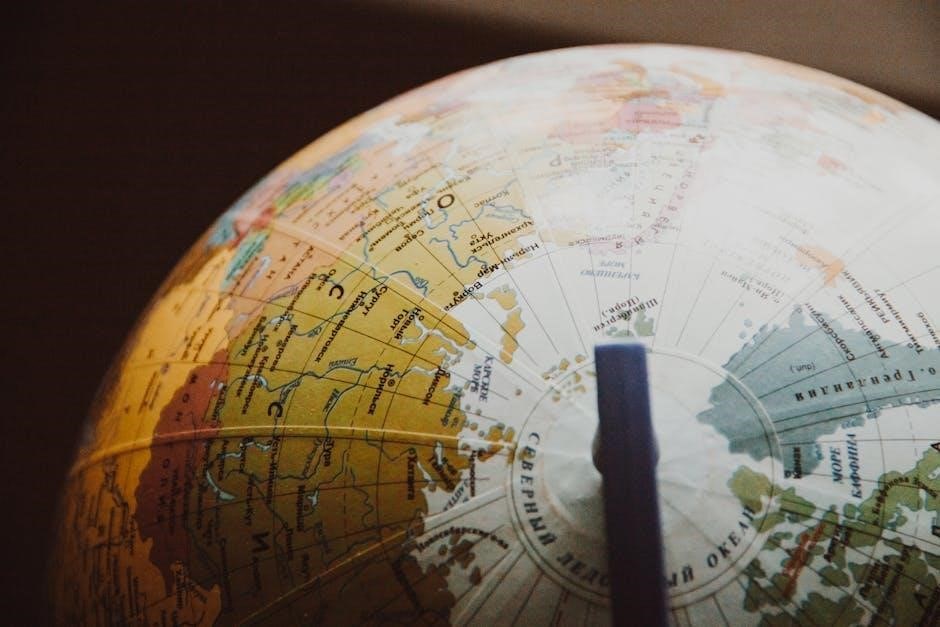Causes of World War I
World War I arose from a complex mix of militarism, alliances, imperialism, and nationalism. The arms race and colonial rivalries fueled tensions, while the Balkans became a volatile hotspot due to ethnic conflicts.
1.1. Militarism and the Arms Race
Militarism and the arms race intensified tensions among European powers. Nations like Britain, Germany, and France heavily invested in military buildup, creating a climate of competition and suspicion. The naval rivalry between Britain and Germany further escalated tensions, making war seem inevitable as armies were prepared for conflict, and diplomatic solutions became increasingly difficult.
1.2. The System of Alliances
The complex system of alliances divided Europe into two opposing blocs: the Triple Entente (France, Russia, Britain) and the Triple Alliance (Germany, Austria-Hungary, Italy). These alliances created a chain reaction after the assassination of Archduke Franz Ferdinand, drawing more nations into the conflict and transforming a regional dispute into a global war.
1.3. Imperialism and Colonial Rivalries
Imperialism and colonial rivalries intensified tensions among European powers, as nations competed for overseas territories, resources, and influence. This competition, particularly in Africa and Asia, fueled economic and political tensions, contributing to the outbreak of World War I by creating an environment of mistrust and rivalry.
1.4. Nationalism and Ethnic Tensions
Nationalism and ethnic tensions played a significant role in the lead-up to World War I. The desire for self-determination among various ethnic groups, particularly in the Balkans, created instability. This heightened sense of national identity and loyalty often led to conflicts between nations and empires, further complicating the already tense political landscape of Europe.
Key Events and Timeline of World War I
The war began with Archduke Franz Ferdinand’s assassination in 1914, leading to declarations of war across Europe. Key events included the Battle of the Marne, Verdun, and the U.S. entry in 1917, culminating in the 1918 armistice and the Treaty of Versailles in 1919.
2.1. The Assassination of Archduke Franz Ferdinand
On June 28, 1914, Archduke Franz Ferdinand, heir to Austria-Hungary’s throne, was assassinated in Sarajevo by Gavrilo Princip, a Serbian nationalist. This event triggered a chain reaction of diplomatic crises and military mobilizations, leading to the outbreak of World War I. The assassination is often cited as the immediate cause of the war.
2.2. Major Battles and Turning Points
2;3. The Entry of the United States
The U.S. initially maintained neutrality, focusing on economic gains. Germany’s resumption of unrestricted submarine warfare and the sinking of the Lusitania outraged public opinion. The Zimmermann Telegram, revealing plans to lure Mexico into war against the U.S., was the final catalyst. On April 6, 1917, Congress declared war, shifting the conflict’s balance.
2.4. The Armistice and End of the War
World War I ended on November 11, 1918, with the Armistice of Compiègne. Exhausted by four years of war, nations agreed to cease hostilities. The armistice followed the collapse of German and Austrian forces, economic strain, and the devastating 1918 influenza pandemic. It marked the end of fighting but set the stage for the Treaty of Versailles.
Major Leaders and Their Roles
Leaders like Kaiser Wilhelm II, Tsar Nicholas II, David Lloyd George, Georges Clemenceau, and Woodrow Wilson played pivotal roles, shaping strategies and negotiating peace, influencing the war’s outcome and the Treaty of Versailles.
3.1. Kaiser Wilhelm II of Germany
Kaiser Wilhelm II, the German Emperor, played a central role in World War I. His aggressive foreign policy and support for Austria-Hungary after Archduke Franz Ferdinand’s assassination escalated tensions. Wilhelm’s pursuit of Weltpolitik, aiming to expand Germany’s global influence, contributed to the arms race and colonial rivalries. His leadership during the war and eventual abdication marked his complex legacy.
3.2. Tsar Nicholas II of Russia
Tsar Nicholas II ruled Russia during World War I, facing internal unrest and military failures. His decision to take personal command of the army worsened his popularity. Defeats and economic hardship led to the rise of the Duma and public discontent. His abdication in 1917 ended the Romanov dynasty, paving the way for the Bolshevik Revolution and Russia’s withdrawal from the war.
3.3. David Lloyd George of Britain
David Lloyd George became Britain’s Prime Minister in 1916, leading with dynamic energy. He formed a wartime coalition, introduced conscription, and boosted national morale. His leadership significantly shaped the Paris Peace Conference and the Treaty of Versailles. Lloyd George’s political maneuvering influenced post-war restructuring, though his legacy remains debated.
3.4. Georges Clemenceau of France
Georges Clemenceau, known as “The Tiger,” was France’s Prime Minister during World War I. He unified French resistance, boosting morale and coordinating Allied efforts; A key figure at the Paris Peace Conference, Clemenceau advocated for harsh terms against Germany. His leadership solidified France’s position, but his rigid stance contributed to post-war tensions that would later fuel World War II.
3.5. Woodrow Wilson of the United States
Woodrow Wilson led the U.S. through World War I, initially maintaining neutrality before entering in 1917. He championed the Fourteen Points, advocating for self-determination and collective security. At the Paris Peace Conference, Wilson fought for his vision, contributing to the Treaty of Versailles and the creation of the League of Nations, though his ideals faced significant opposition and challenges in implementation.

The Home Front During World War I
The home front saw significant changes, with economic mobilization, propaganda shaping public opinion, and women entering the workforce. Social dynamics shifted as societies adapted to wartime demands.
4.1. Economic Mobilization and War Production
Nations redirected their economies to support the war effort, increasing production of weapons, ammunition, and supplies. Governments implemented rationing and controlled industries to manage resources. This shift strained economies but ensured sustained military and civilian needs, highlighting the war’s profound impact on societal and industrial structures.
4.2. Propaganda and Public Opinion
Governments employed propaganda to shape public opinion, promoting patriotism and demonizing enemies. Posters, films, and media spread nationalistic messages, fostering support for the war. This manipulation of information influenced societal attitudes, maintaining morale and justifying the conflict, though it often distorted reality and fueled hatred among nations.
4.3. The Role of Women in the War Effort
During World War I, women took on unprecedented roles in the workforce and military. They filled labor shortages in factories, agriculture, and services, while also serving as nurses and in auxiliary military roles. This shift challenged traditional gender norms and laid the groundwork for future feminist movements, proving women’s capabilities beyond domestic duties.
4.4. Social and Political Changes
World War I spurred significant social and political shifts. Governments expanded their powers, implementing conscription and rationing. Class divisions narrowed as societal unity grew, and women gained suffrage in some countries. Politically, the war led to the rise of new ideologies and the collapse of empires, reshaping the global political landscape.

Technology and Warfare in World War I
World War I introduced groundbreaking technologies like tanks, airplanes, and chemical weapons, revolutionizing combat. Trench warfare dominated battlefields, while advancements in artillery and machine guns intensified destruction, changing the nature of modern warfare forever.
5.1. Trench Warfare and Its Impact
Trench warfare dominated World War I, with soldiers enduring squalid conditions, constant artillery fire, and massive casualties. The stalemate led to prolonged battles and psychological trauma. Rats, lice, and disease plagued troops, while barbed wire and machine guns made crossing no man’s land deadly. This brutal tactic defined the war’s brutal reality and lasting impact.
The introduction of advanced artillery and machine guns revolutionized warfare. Artillery enabled long-range bombardments, causing widespread destruction, while machine guns like the Maxim and Vickers allowed for rapid, sustained fire, leading to unprecedented casualties. These innovations rendered traditional tactics obsolete, deepening the stalemate and horrors of modern combat in World War I.
5.3. The Use of Chemical Weapons
The use of chemical weapons in World War I marked a horrific escalation in warfare. Chlorine and mustard gas caused severe burns, respiratory failure, and long-term suffering. Their deployment terrorized soldiers, leading to the development of gas masks and protective gear. This inhumane tactic left deep psychological scars and prompted eventual bans on chemical warfare.
5.4. The Development of Tanks and Airplanes
Tanks were introduced to break trench warfare stalemates, equipped with machine guns to clear enemy lines. Airplanes evolved from reconnaissance tools to fighter jets, engaging in dogfights and bombing missions. These innovations revolutionized warfare, showcasing technological advancements and their devastating potential, while shifting military strategies and tactics during the conflict.

The Treaty of Versailles and Its Consequences
The Treaty of Versailles ended World War I, imposing harsh terms on Germany, including heavy reparations and territorial losses. This fueled economic hardship and resentment, contributing to the rise of fascism and setting the stage for World War II.
6.1. The Main Terms of the Treaty
The Treaty of Versailles imposed significant reparations on Germany, mandated territorial losses, and limited its military capabilities. It also established the League of Nations to promote international cooperation and prevent future conflicts, while redrawing national borders to reflect the collapse of empires.
6.2. The War Guilt Clause and Reparations
The Treaty of Versailles blamed Germany for causing the war through the War Guilt Clause, leading to severe reparations. These financial penalties crippled Germany’s economy, fostering widespread resentment and economic hardship, which destabilized the Weimar Republic and contributed to the rise of Nazi Germany.
6.3. Territorial Changes and Redrawing Borders
The Treaty of Versailles led to significant territorial shifts, dissolving empires and redrawing borders. The Ottoman and Austro-Hungarian Empires collapsed, while new nations like Poland and Czechoslovakia emerged; Germany lost substantial territory, and self-determination reshaped Europe, though not without controversy. These changes sowed seeds of future tensions and reshaped the global political landscape.
6.4. The Establishment of the League of Nations
The League of Nations was created at the Paris Peace Conference to promote international cooperation and prevent future wars. Founded in 1920, it aimed to resolve conflicts through diplomacy and collective security. However, its effectiveness was undermined by the absence of major powers like Germany and the United States, leading to its eventual failure in preventing World War II.

The Legacy and Impact of World War I
World War I reshaped geopolitics, leading to the fall of empires, the rise of fascism and communism, and widespread economic hardship, while also sparking social change.
7.1. The Rise of Fascism and Nationalism
Post-World War I, economic crises and the Treaty of Versailles fueled nationalist sentiments. Hyperinflation in Germany and widespread discontent enabled extremist ideologies to rise, fostering authoritarian regimes. Leaders like Hitler and Mussolini exploited these conditions to promote aggressive nationalism, laying groundwork for future conflicts and reshaping political landscapes across Europe.
7.2. The Interwar Period and the Lead-Up to World War II
The interwar period was marked by instability following the Treaty of Versailles. Economic crises like the Great Depression fueled extremism, enabling Hitler’s rise. Appeasement policies allowed Nazi expansion, and the League of Nations’ ineffectiveness failed to prevent the resurgence of aggression, setting the stage for WWII.
7.3. The Decline of European Empires
World War I accelerated the decline of European empires, with Germany, Russia, Austria-Hungary, and the Ottoman Empire collapsing. Economic exhaustion, political instability, and rising nationalism led to their dissolution. The war also weakened colonial powers, fostering independence movements and reshaping global power dynamics, as the U.S. and Soviet Union emerged as new dominant forces.
7.4. The Psychological and Social Effects on Veterans
World War I left veterans with profound psychological trauma, including shell shock and post-traumatic stress disorder (PTSD). Many suffered from chronic mental health issues, social isolation, and difficulty reintegrating into civilian life. The horrors of trench warfare and exposure to chemical weapons like mustard gas exacerbated these struggles, leaving lasting scars on soldiers and their families.

Leave a Reply
You must be logged in to post a comment.